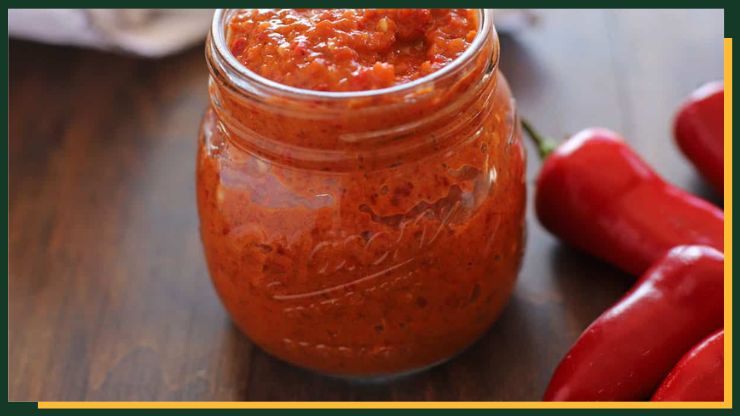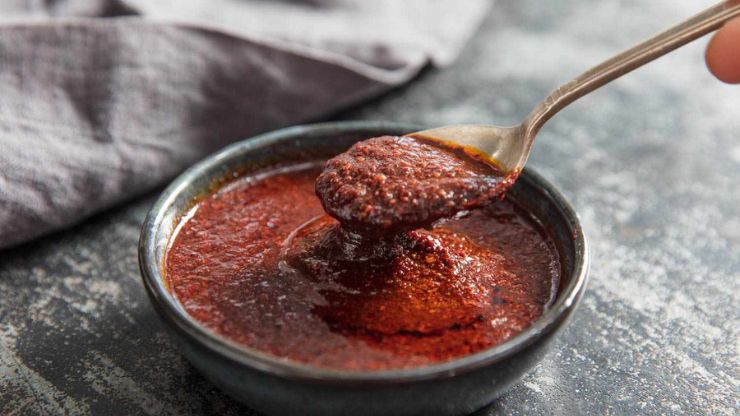How to Make Harissa Chili Sauce – Harissa Chili Sauce, a North African and Middle Eastern condiment, adds bold, spicy flavor to a variety of dishes. This versatile sauce, typically made from dried red chili peppers, garlic, and aromatic spices, holds cultural significance in many cuisines.
Its intense heat and rich, smoky undertones make it a favorite for those seeking to elevate the taste of their meals. Crafting this sauce at home allows for customization, adjusting the spice level and flavors to personal preference.
You can add flavor to grilled meats, vegetables, and a variety of other dishes by making your own Harissa chili sauce at home with the help of this easy-to-follow instruction. Let’s embark on a journey to savor the vibrant and authentic taste of homemade Harissa!
Table of Contents
ToggleOverview of Harissa Chili Sauce
Harissa Chili Sauce, a fiery North African and Middle Eastern condiment, blends dried red chili peppers, garlic, and spices for a bold, smoky flavor. This versatile sauce, rich in cultural significance, adds an intense kick to dishes.
Easily customizable, it allows for personalization of spice levels. Ideal for elevating grilled meats, vegetables, and various recipes, homemade Harissa promises a vibrant and authentic culinary experience.
Also, Read – Probiotic Fig Butter
How to Make Harissa Chili Sauce

Harissa is a North African chili paste or sauce that adds a burst of spicy and flavorful goodness to a variety of dishes. Here’s a basic recipe for making Harissa chili sauce at home:
Ingredients:
- 10-12 dried red chili peppers (such as Fresno or red jalapeños), stems removed
- 3 cloves garlic, peeled
- 1 teaspoon caraway seeds
- 1 teaspoon coriander seeds
- 1 teaspoon cumin seeds
- 1/2 teaspoon smoked paprika
- 1/2 teaspoon salt, or to taste
- 3 tablespoons olive oil
- 1 tablespoon tomato paste
- 1 tablespoon lemon juice
Prepare the Chili Peppers
Soak 10-12 dried red chili peppers in hot water for about 30 minutes until they become soft and pliable. Once the peppers are rehydrated, drain the water from them. This step helps to soften the chilies, making them easier to blend into a smooth paste for the harissa sauce.
Ensure that the peppers are fully submerged in the hot water during the soaking process. Once done, they should have a more flexible and tender texture, ready to be incorporated into the next steps of the harissa preparation.
Toast the Seeds
In a dry skillet over medium heat, toast 1 teaspoon each of caraway seeds, coriander seeds, and cumin seeds for a few minutes until they release their aroma. Stir the seeds frequently to prevent burning.
Toasting enhances the spices’ flavors and adds depth to the harissa sauce. Be attentive to the process, as over-toasting can result in a bitter taste. Once the seeds are fragrant, remove them from the heat promptly.
This toasting process adds to the handmade harissa’s overall depth and richness, making it a delightfully aromatic condiment or ingredient for a variety of cuisines.
Grind the Spices
Using a spice grinder or mortar and pestle, finely ground the toasted caraway, coriander, and cumin seeds. The whole taste potential of the spices is released during this procedure, adding to the harissa sauce’s aromatic profile.
Aim for a smooth consistency to ensure even distribution of flavors in the final product. Grinding the spices just before incorporating them into the sauce helps to maintain their freshness and intensifies the overall taste.
Don't just scroll, subscribe!
BuzzTrail's unique web-stories are the cure for boredom you've been waiting for.
The final spice mixture will play a major role in producing a tasty, well-balanced homemade harissa that will enhance a number of foods.
Also, Read – How to Make Probiotic Creme Fraiche
Blend Ingredients
In a food processor, combine the softened and drained dried red chili peppers, 3 peeled garlic cloves, ground caraway seeds, coriander seeds, and cumin seeds, 1/2 teaspoon smoked paprika, 1/2 teaspoon salt, 3 tablespoons olive oil, 1 tablespoon tomato paste, and 1 tablespoon lemon juice.
Blend the ingredients together until a creamy, vibrant concoction is formed. The garlic adds pungency, while the spices and smoked paprika contribute depth and warmth. Adjust the texture by drizzling in more olive oil if needed. This harmonious blend creates a versatile harissa sauce, perfect for adding a spicy kick and robust flavor to various dishes.
Blend Until Smooth
Process the mixture in the food processor until a velvety and well-integrated paste forms. This blending step ensures that the chili peppers, garlic, and spices combine seamlessly, creating a homogenous and smooth texture for the harissa sauce.
The process of blending produces a well-balanced and fragrant condiment by breaking down the ingredients into a cohesive mixture and allowing the tastes to mingle.
Watch the consistency; if the harissa seems too thick, you might try to blend in a bit extra olive oil to achieve the desired level of smoothness. This final stage transforms the individual components into a harmonized, flavorful sauce ready to enhance your culinary creations.
Adjust Seasoning
Taste the harissa and fine-tune the flavor to your liking. Assess the balance of spices, heat, and acidity. Add more salt if it’s necessary for the flavor to be balanced. You could also want to squeeze in a little extra lemon juice for brightness.
Adjusting the seasoning is a personal touch, so trust your palate and preferences. This step ensures that the harissa aligns with your desired flavor profile, whether you prefer it spicier, more savory, or with a hint of tanginess.
Take small increments when adding seasonings to prevent overdoing it, allowing you to achieve the perfect, customized taste for your homemade harissa sauce.
Store
Spoon the newly prepared harissa sauce into a sanitized, sealed jar or other container. Seal it well to preserve the flavors. Store the harissa in the refrigerator for optimal freshness and longevity, where it can last for up to a few weeks.
The cold temperature helps maintain its quality. Always use a clean utensil when scooping out harissa to prevent contamination. Enjoy this versatile sauce by adding it to various dishes, and explore the exciting ways it can enhance your culinary creations with its bold and spicy character.
Serve
Serve the homemade harissa sauce as a flavorful condiment or ingredient. It pairs wonderfully with grilled meats, roasted vegetables, couscous, or as a spicy dip. Spoon it onto your favorite dishes to add a kick of heat and depth of flavor. Experiment with incorporating it into recipes to elevate your culinary creations with the bold and vibrant taste of homemade harissa.
Conclusion
In conclusion, crafting your own Harissa Chili Sauce provides a satisfying culinary adventure. With its bold spice profile and cultural roots, this homemade condiment enhances diverse dishes. Experiment, adjust flavors to taste, and savor the satisfaction of creating a personalized and authentic Harissa that will undoubtedly elevate your culinary creations. Enjoy the vibrant and fiery journey in every bite!
FAQs
Can I adjust the spiciness of Harissa Chili Sauce?
Can I adjust the spiciness of Harissa Chili Sauce?
Absolutely! You can control the spice level by varying the amount of chili peppers or by choosing milder or spicier varieties.
How long does homemade Harissa last?
How long does homemade Harissa last?
When stored in airtight containers in the refrigerator, homemade Harissa can last for several weeks to a few months. Be sure to check for any signs of spoilage.
Can I use fresh chili peppers instead of dried ones?
Can I use fresh chili peppers instead of dried ones?
While traditionally made with dried chili peppers, you can experiment with fresh ones. Keep in mind that this may alter the flavor and consistency.

